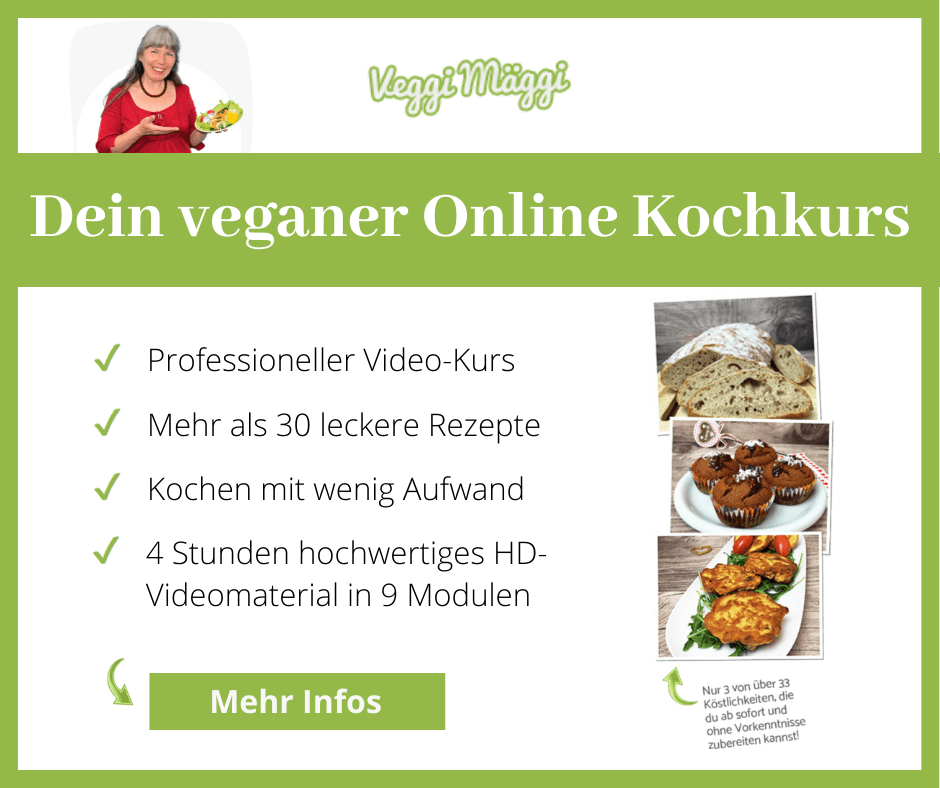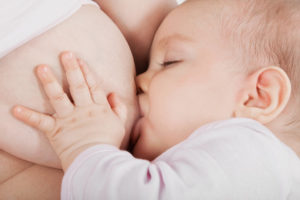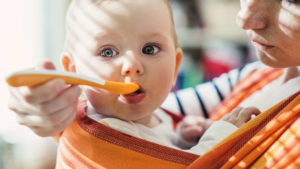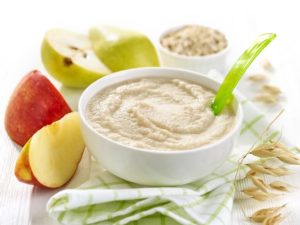Freezing baby food is not only an issue from the seventh month. You can feed your child baby food as early as the fourth month. However, in the beginning the portions are still tiny because baby’s stomach is so small that freezing doesn’t seem worth it.
So it’s a lot of effort for mini portions? We’ll show you how to do it right: freezing is so easy that success really only depends on the right organization. Whether it’s freezing zucchini or spinach, it takes a little basic knowledge to ensure that your child is eating a safe food.
Freezing baby food is considered time-consuming. But that’s not true. On the contrary, a little basic knowledge actually gives you more time for your child. Read all about freezing, thawing and good hygiene here.
Table of contents
Freezing Baby Food: Is It Even Possible?
In principle, you can freeze any baby food: home-cooked food as well as store-bought baby food in jars. That’s why freezing baby food is really not difficult. But if you cook it yourself, you often despair of the tiny portions: You always have to throw something away.
That’s a waste of food, of course. But there is another way: Many young fathers or mothers decide at some point to cook in advance. What’s too much is frozen without further ado.
This approach seems time-consuming, but it’s not. After all, the effort only comes once, and many parents appreciate the two-week rhythm. If you stick to this, you will have two weeks of peace. For example, when freezing zucchini, you only have to cook and puree one zucchini once. After freezing zucchini, you will always have a meal ready.

Freeze Baby Food: The Advantages
- Saves money and food: with smart planning, everything is used up.
- Costs little time because you don’t always have to cook fresh, just defrost.
- Ensures longer shelf life of food.
Are There Any Disadvantages To Freezing Baby Food?
Baby food consists of cooked food that has been pureed. Bacteria and germs have the best chance to multiply rapidly in it. Another prerequisite is a temperature at which the bacteria feel comfortable.
Normally, this is heat. Freezing therefore serves to keep the development of germs in check. Only then will the food keep longer and can still be eaten months later.
Freezing Baby Food Means Saving Time
For many parents, a fourteen-day rhythm has proven successful. It’s doable, even with very little time. And it allows parents to keep track of supplies at all times. Even if something isn’t consumed in those fourteen days and stays longer, it doesn’t exceed the shelf life of the food in question.
Freezing baby food: This is how long foods can be kept:
- Fruits and vegetables up to 6 months.
- Meat and fish up to 3 months.
Important: Freezing only stops the bacteria, but does not kill them. Therefore, do not store food for too long! For example, you can freeze zucchini to eat within half a year.
However, quick consumption is always better. With good planning, however, you can freeze baby food so that it doesn’t spend months in your freezer: then you’ll always use up what you’ve prepared in the last few weeks.
Hygiene Comes First
To keep germs and bacteria to a minimum, you should pay attention to good hygiene in everything you do. This includes the cleanliness of work equipment such as cutting boards and knives. If you have prepared something with meat before freezing zucchini, clean your board thoroughly before continuing.
Here is an overview of the important rules you should follow:
- Thoroughly clean the board and knife after each operation.
- Never freeze porridge that you have already touched with a used spoon.
- Do not forget to wash your hands frequently.
Make Your Own Baby Food: What Foods Should Not Be Frozen?
There are a few exceptions to the rule of thumb that you can freeze anything. Some foods are less suitable, because they change the taste, others the consistency. However, most of them are not really dangerous for your child, so you can safely make baby food out of them.
The situation is different with foods containing nitrates. At this point, therefore, a warning.
Caution With Spinach
This food contains a lot of nitrate. Therefore, avoid feeding your child large amounts of it. Especially for infants this can be dangerous, because the nitrate is degraded to nitrite. In the child’s body, this changes the red blood cells, which in turn leads to an inadequate oxygen supply.
But how much is a large amount? That is difficult to estimate. It is therefore best to avoid such foods altogether during the first year of life.
Freeze Kohlrabi
This is also a food rich in nitrates. The same applies as for spinach! If you want to freeze kohlrabi for baby food, please do so only from the second year of life.
Nitrate-rich foods at a glance:
- Spinach
- Kohlrabi
- Beet
- Fennel
- Swiss chard
Low in nitrates, on the other hand, are carrots, broccoli, parsnips, or even cauliflower. Freezing zucchini is also perfectly fine. These foods are also safe for small babies. By the way, organic foods generally contain less nitrate!

Other Foods That Can Be Problematic To Freeze When Making Baby Food
Dairy foods: While they can be frozen without losing flavor or consistency. Cow’s milk and raw milk products. The risk of salmonella infection would simply be too great here.
But germs spread particularly quickly in warm milk. To be on the safe side, you should therefore prepare a porridge with fresh milk. In general, this can be done quickly and does not require much effort, so it is feasible.
Avocado
Here it is more about the taste, because avocado becomes bitter when frozen. Some children then refuse to eat it.
Banana
Becomes unsightly and spoils the consistency of the porridge.
Oil
Of course, a good baby porridge needs oil for better absorption of the valuable vitamins in it. But it is better to add oil after defrosting. The reason: it significantly changes the taste and consistency of baby food during freezing. The same applies to spices.
Citrus Fruits
They should not be frozen either, but they are not appropriate for very small babies. The acid they contain can harm a baby’s sensitive sore bottom when eliminated. Other babies may develop redness around the mouth, and even though they actually like the taste.
Potatoes
Potatoes have a lot of starch. This changes the consistency of the porridge, which becomes visible after thawing. The baby porridge then becomes grainy and falls apart. The same is true for rice and pasta.
So even if it is often recommended that these ingredients can be used without hesitation, this is only half right. There are children who don’t mind this at all. Other babies, on the other hand, don’t like it at all and refuse.
That’s a long list. But what can be safely frozen?
Freezing Baby Food: These Ingredients Are Safe In All Respects
Freezing zucchini works, as do pumpkin, carrots and applesauce. These are the classics of baby food. But meat of different varieties is also suitable, as well as fish. Freshness and cleanliness are always the prerequisites for proper baby food freezing.
- Zucchini
- Apple
- Pumpkin
- Meat, fish
What else you should pay attention to when preparing baby food, you can find out here!
Freeze Baby Food – This Is How It Works!
If you want to freeze baby porridge, you should separate the individual porridges. So prepare meat separately, vegetables as well! The reason is not only the different shelf life of the food.
Above all, your baby will not eat as much meat in the first few weeks after the start of supplementary feeding. Therefore, portion it separately, then you can also defrost it in small portions. Only then are you sure to always have the right amount on hand.
1. Small Portions, Airtight
This is the secret of freezing: Think ahead. When freezing zucchini, for example, small portions ensure that nothing or not as much is left over after feeding. You can use ice cube trays for this. But don’t forget to transfer them airtight into a freezer bag or other container afterward.
2. Cool Quickly
The slower the cooling process, the better the bacteria will fare. No matter how clean you work, some of them will still develop inside the baby pudding. It is therefore important to prevent them from spreading as much as possible.
This works through temperature. The faster you cool the food, the better! If you don’t have a special freezing mode, simply use a water bath with ice cubes. As soon as the food is at room temperature, it goes into the freezer.
3. Freezing Baby Food Containers: Silicone Or Glass?
Containers for baby food should be airtight. This allows you to use anything that is intended for freezing anyway.
Tip: Use simple ice cube containers to freeze small portions. Once everything is frozen, simply transfer it to sealable freezer bags.
Ready-made baby food jars can also be frozen, but only if you have not already taken something out with a used spoon. Advantage: You can put them in the baby food warmer to defrost, if you have one.
Silicone, on the other hand, has the advantage of being flexible. It is very suitable for freezing baby food: Frozen food can be easily removed, for example, for reheating on a plate in the microwave.
4. Freezing – What Else You Need To Keep In Mind For Preparation
- Boil containers before filling them.
- Do not fill containers completely, frozen food expands when frozen.
- Do not store outside for too long, even overnight in the refrigerator. Always remember: the colder, the less chance bacteria have.
This is the right temperature for freezer storage:
The ideal temperature for storing baby formula is minus 18 degrees Celsius. If you store above that, your baby food may not last quite as long. The warmer, the more active harmful bacteria become!
Labeling containers prevents kitchen chaos.
But how do you keep track of everything? It’s simple: label every container you fill. Write down the contents and date on a label. Then you’ll always know what has to go when! Ideally, however, you won’t need these notes at all, because you’ve planned well and will use everything up again soon.
Defrosting Baby Food: This Is What You Have To Keep In Mind
- Do not refreeze defrosted baby food. Each time you defrost, more germs and bacteria develop. Their growth is only inhibited by freezing – but they are not killed.
- Do not defrost too hot, otherwise vitamins will be lost. But don’t defrost too slowly either, or bacteria will grow.
- Use up defrosted food within 24 hours, otherwise throw it away.
- When heating in the microwave, make sure containers do not contain melamine. These are suspected of releasing harmful substances when heated.
There are the following ways to defrost baby food:
- Microwave.
- Water bath.
- Special baby food warmer.
Make sure the water bath is only about 70 degrees. Don’t forget to stir everything well after heating, this also applies to the microwave. Otherwise, your baby may burn himself while feeding.
Freezing Baby Food
Whether home-cooked or baby food from a jar: almost everything can be frozen without any problems. If you do this in advance, you save time above all: instead of having to cook every meal from scratch, you only have to defrost it. Have you already read up on complementary feeding?
But you also put a stop to food waste. You won’t have to throw anything away so often, especially if your baby is still very small and doesn’t manage much. Freezing baby food is therefore a good solution, especially for parents with little time. It sounds paradoxical, but it’s true: you only have to make the big effort once every two or three weeks.
However, there are some foods that are not suitable, especially for very small babies. You should not give them at all in the first year of life. This applies to all foods that are rich in nitrates.
This applies to spinach, kohlrabi, fennel, beet and chard. From the age of one year, the administration of these foods is also unproblematic. Classics, on the other hand, are apple or carrot – freezing zucchini is also possible without any problems.
It is always important to observe basic hygiene rules. If you follow them when freezing baby food, you will soon have a good supply of baby food to fall back on.











2 thoughts on “Can You Freeze Baby Food? This Is What You Should Keep In Mind”